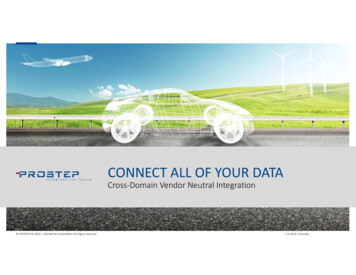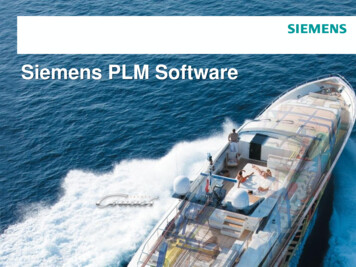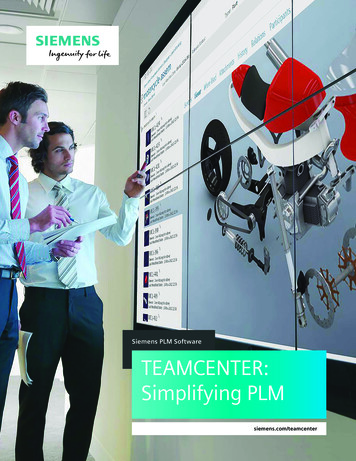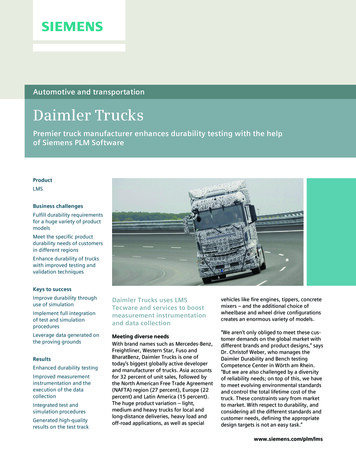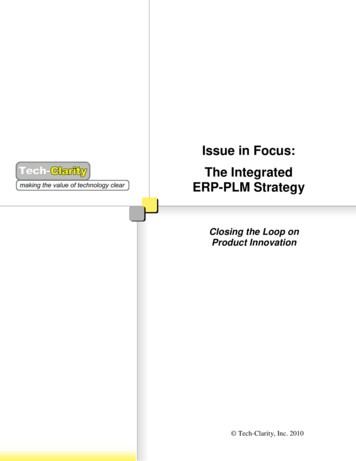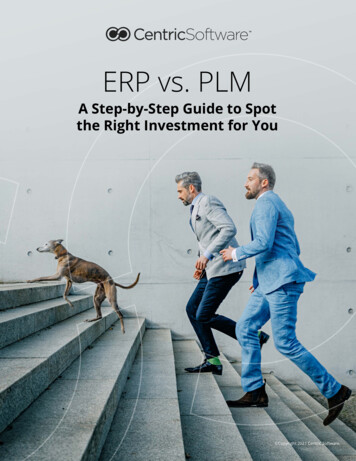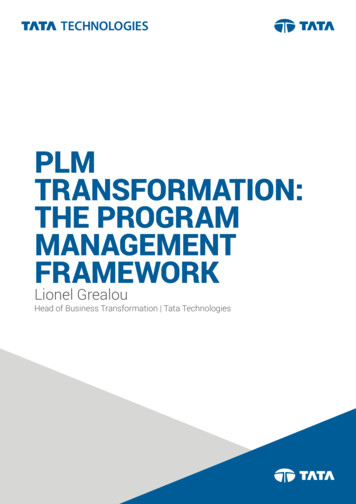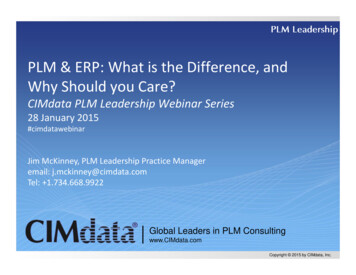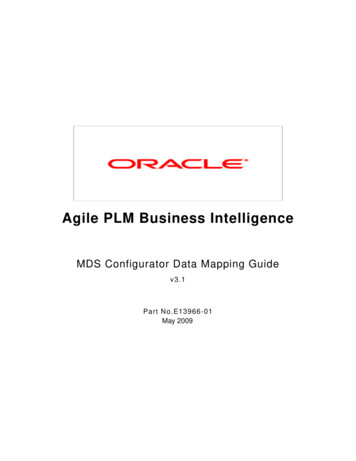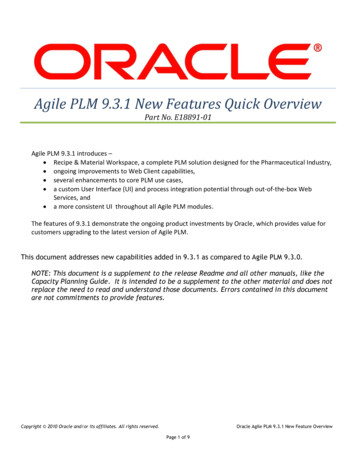
Transcription
Paper No. W4, pp. 1-6SadržajHomeXVI Conference DEVELOPMENT TRENDS:“ Bologna 2010: State, Dilemmas and Perspectives ”Kopaonik, Serbia, 1-4 March 2010.Joint Tempus Projects Workshop JADES – SoCD – MAS-PLMSIEMENS PLMTihomir ErdeljacIndustrial Technology Systems, Prague, Czech Republictihomir.erdeljac@itscz.net1. INTRODUCTIONSiemens PLM Software is today world leader in supplying PLM (Product LifecycleManagement). The following text is explaining basics of Siemens PLM Software solution. Text isprepared by Industrial Technology Systems – Siemens PLM partner responsible for distributionand implementation of complete solution in Czech Republic, Serbia, and Macedonia.2. WHAT IS PLM?Product Lifecycle Management (PLM) enables the kind of convergence that EnterpriseResource Planning (ERP) and Customer Relationship Management (CRM) prompted in thepast. In the early 90s, ERP unified finance, HR, manufacturing and warehouse systems. Adecade later, CRM brought call centre and sales force automation together. Now, ComputerAided Design (CAD), Computer-Aided Manufacturing (CAM), Product Data Management (PDM)and manufacturing process are converging through PLM. Yet PLM is unique from otherenterprise software solutions because it focuses on driving top-line revenue from repeatableprocesses. Through PLM, your products are a path to innovation, industry leadership, and topline growth.2.1 Build the right productIn today’s demanding global economy, product success depends on your ability to beatyour competitors to market with products that capture your customers’ imagination with stylishyet appropriately functional content that performs as required while being delivered at a pricethe market is willing to pay. In other words, your products must be able to satisfy customerrequirements for Timing, Function, Performance, Style, and Price.Since these variables frequently change during the course of a product lifecycle, yourinnovation process must be able to account for change and easily accommodate its demandson a systematic and repeatable basis.2.2 Build the product rightDelivering the right product to market is only half the battle that today’s product makers’face. Best-in-class companies employ lean manufacturing and design for-manufacturinginitiatives to optimize the product lifecycle’s downstream processes. The goal here is to enableproduct development teams and manufacturing teams to work together as early in the productlifecycle as possible with an eye to: Minimizing production cost, Improving product quality,Delivering more reliable products, Providing easier to service products, Driving “green”initiatives that facilitate a sustainable environment.2.3 Definition of PLMProduct lifecycle management is an integrated, information-driven strategy that speeds theinnovation and launch of successful products. It is built on a common platform that serves as a1
XVI Conference DEVELOPMENT TRENDS:“ Bologna 2010: State, Dilemmas and Perspectives ”Kopaonik, Serbia, 1-4 March 2010.Joint Tempus Projects Workshop JADES – SoCD – MAS-PLMsingle repository of all product-related knowledge, data, and processes. As a business strategy,PLM lets distributed organizations innovate, produce, develop, support, and retire products, asthey were if they were a single entity. It captures best practices and lessons learned, creating astorehouse of valuable intellectual capital for systematic and repeatable re-use. As aninformation technology strategy, PLM establishes a coherent data structure that enables realtime collaboration and data sharing among geographically distributed teams. PLM letscompanies consolidate multiple application systems while leveraging existing legacyinvestments during their useful lives. Through open APIs and adherence to industry standards,PLM minimizes data translation issues while providing users with information access andprocess visibility at every stage of the product’s life.3. SIEMENS AND PLMSiemens PLM Software, a business unit of the Siemens Industry Automation Division, is aleading global provider of product lifecycle management (PLM) software and services with 6.7million licensed seats and 63,000 customers worldwide. Headquartered in Plano, Texas.Siemens PLM Software’s vision is to enable a world where organizations and their partnerscollaborate through Global Innovation. Networks to deliver world-class products and serviceswhile leveraging Siemens PLM Software’s open enterprise solutions, fulfilling the mission ofenabling them to transform their process of innovation.3.1 Siemens PLM softwareSiemens PLM Software has either the #1 or #2 market share in all major market segmentsof the PLM space. This includes the overall PLM market as well as the individual segments ofCAx, cPDM and DM. Siemens PLM Software has strong presence across most major industrysegments in today’s market (Fig. 1). The diversity of its business underscores Siemens PLMSoftware understanding of PLM and the close working relationship it has with customers in allindustries. It also is a strong testament to the strength that Siemens PLM Software solutionshave in delivering value across multiple industries.3.2 Siemens PLM software’s enterprise solutions portfolioOur software product portfolio is represented by these four product brands (Fig. 2):- NX for Digital Product Development- Tecnomatix for Digital Manufacturing- Teamcenter for Digital Lifecycle Management- Velocity Series that provides PLM for small and mid-sized businesses.Fig. 1 Revenue mix by industriesFig. 2 Product portfolio2
XVI Conference DEVELOPMENT TRENDS:“ Bologna 2010: State, Dilemmas and Perspectives ”Kopaonik, Serbia, 1-4 March 2010.Joint Tempus Projects Workshop JADES – SoCD – MAS-PLM3.2.1 Digital product development - nxNX suite of products is organized into these fundamental capability areas (Fig. 3): IndustrialDesign & Styling, Package Design, Mechanical Design, Electro technical Design, MechanicalSimulation, Electromechanical Simulation, and Tooling & Fixture Design Machining, and can bedelivered either individually to address a very specific customer need or integrated with otherNX capabilities to provide even higher levels of value in Digital Product Development.3.2.2 Digital manufacturing - tecnomatixTecnomatix suite of products are organized into these fundamental capability areas andcan be delivered either individually to address a very specific customer need or integrated withother Tecnomatix capabilities to provide even higher levels of value in Digital Manufacturing.Tecnomatix improves planning productivity of manufacturing planning processes. At thesame time, Tecnomatix drives manufacturing productivity in many areas, including optimizationand commissioning of robotics and automation, manual workplace configuration, and optimalplacement of equipment and material flow (Fig. 4).Fig. 3 Capability areas of NX suite of productsFig. 4 Digital manufacturing3.2.3 Digital lifecycle management - teamcenterSiemens PLM’s Teamcenter is the world’s most widely used PLM system (Fig. 5).Teamcenter provides a Single Source of product and process knowledge to enable GreaterProductivity. Moreover, you can have Greater Teamwork through instant collaboration.Teamcenter enables global teams and suppliers to connect, communicate and collaborate.Anybody, anywhere, anytime collaboration. Teamcenter powers end-to-end PLM and givescompanies Greater Control with the PLM industries broadest and deepest set of capabilities.(highlight solution blocks on right as examples depending on the audience). Teamcenter alsoprovides Greater Manageability by lowering the cost of ownership though configuration vs.customization, an open data model, simple user interface, and it’s Services OrientedArchitecture. Moreover, Siemens PLM helps companies have Greater Success throughTeamcenter’s Proven Global Leadership in the marketplace with over 4M licenses ofTeamcenter sold!3.2.4 PLM for small and mid-sized businessesVelocity Series suite of products provides full PLM capability for small to mid-sizedbusinesses who face many of the same product and process complexities as large, enterprisecompanies but who don’t have access to the same resources as those large companies (Fig. 6).3
XVI Conference DEVELOPMENT TRENDS:“ Bologna 2010: State, Dilemmas and Perspectives ”Kopaonik, Serbia, 1-4 March 2010.Joint Tempus Projects Workshop JADES – SoCD – MAS-PLMThe Velocity Series of design, simulation, manufacturing, and data management solutionsis tailored for small and mid-sized businesses: Modular, yet integrated solutions, Easy to deploy& use (in Native Microsoft), Preconfigured with industry best practices, Low total cost ofownership, and Scalable to full range of Siemens PLM Software solutions.Fig. 5 Digital LifecycleManagement - TeacenterFig. 6 PLM for small and mid-sized businesses4. PLM BUSINESS VALUEWhen you work with Siemens PLM Software, you can move forward strategically whileachieving near-term results. An open, standards-based portfolio of PLM solutions spans theproduct lifecycle and establishes a platform for innovation. As you address specific businessissues, you build a solid foundation for future success. Once your PLM platform and thesolutions you deploy on top of it are in place, your company will be able to realize measurableinnovation benefits both immediately and over the long term (Fig. 7).Fig. 7 PLM business value4.1 Accelerate launchTraditionally, companies brought their products to market in time-consuming serialprocesses that delayed the participation of downstream contributors, such as suppliers,manufacturing experts and service/maintenance providers. By allowing you to execute as manylifecycle tasks as possible in parallel processes, PLM enables you to streamline and collapsecritical stages in your product lifecycle. PLM delivers aligned, accurate, and highly synchronizedproduct knowledge to multiple disciplines early in your lifecycle – thereby avoiding the cost andscheduling impact that comes when late suggestions and unexpected concerns arise fromdownstream players. PLM enables you to beat the competition to market with innovative productcontent that carries first to-market advantages and drives early product sales.4
XVI Conference DEVELOPMENT TRENDS:“ Bologna 2010: State, Dilemmas and Perspectives ”Kopaonik, Serbia, 1-4 March 2010.Joint Tempus Projects Workshop JADES – SoCD – MAS-PLM4.2 Increase profitable growthPLM allows you to create, capture and share the product-related requirements,expectations and preferences of targeted customers and markets and align these requirementswith specific innovative content that your customers want for a price they can afford at the timewhen it is needed. PLM lets you vet new product ideas against quickly rising customerrequirements and cost effective manufacturability. Global cross-functional teams collaborate inreal time on the ideation process, each contributing their unique experience and perspective.Knowledge and “lessons learned” are captured for potential re-use in a process of continualinnovation. PLM facilitates mass customization by enabling you to rapidly and cost effectivelydeliver customized product offerings that satisfy the needs of individual customers and targetedmarket segments. PLM combines the advantages of configuration management with option andvariant management. These state-of-the-market capabilities allow you to perform portfolioplanning in as flexible and continuous a process as possible.4.3 Reduce build costPLM allows you to slash cost across all of the stages in your product lifecycle – which inturn, enables you to minimize the cost of the product offerings that you plan, develop,manufacture, and support. For example, by leveraging PLM to understand the time andresource impacts of proposed design changes and requirements changes, you can makedecisions that minimize your lifecycle and product costs. By using PLM to catch design flaws upfront in your lifecycle, you can avoid the cascading rework and cost associated with changingyour products during the manufacturing stages of your product lifecycle. You can use PLM toincorporate the concerns of your maintenance and service groups into your product designs andminimize warranty costs. By digitally creating and re-using your manufacturing plans, plantinformation and manufacturing processes, you can reduce your overall operational costs. Youcan also use PLM to implement virtual prototyping that enables you to drastically reduce thevalidation costs associated with physical prototyping.4.4 Extend lifecycle returnsPLM enables you to cost effectively deliver product enhancements, derivatives, nicheofferings and add-ons that extend the profitable duration of your product lifecycle. PLMfacilitates this objective by enabling you to create product platforms that you can use toaccelerate your start up processes, minimize your take to market cost and maximize therevenue generated by a product’s initial release – as well as by its successors and derivatives.4.5 Re-use best practicesPLM enables you to maximize the re-use of your best-practice processes, intellectualcapital, human resources, product plans, production plans, production facilities and value chainsacross a continuing set of take-to-market programs. New take-to market programs can bequickly started and continuously improved because you have a full and complete set of productand production management capabilities at your fingertips. There is rarely a need to start newprograms entirely from scratch. PLM-driven re-use is especially valuable because it facilitatesmass customization, which enables you to rapidly and cost effectively respond to customerdemands for more personalized products.5
XVI Conference DEVELOPMENT TRENDS:“ Bologna 2010: State, Dilemmas and Perspectives ”Kopaonik, Serbia, 1-4 March 2010.Joint Tempus Projects Workshop JADES – SoCD – MAS-PLM5. APPLICATION OF PLM5.1 Medium to large corporationsIn the current economic climate, addressing global business challenges is the top priority ofmost medium and large enterprises.Whether they want to expand their customer base in new markets, or to leverage morecost- competitive resources, conducting their business globally is a necessity. To sustain anadvantage, they have to overcome the challenges of a dispersed organization, while stillempowering individual team members to excel.Siemens enterprise PLM software offers comprehensive solutions to help them addresstheir challenges and create competitive advantage. Five areas where Siemens medium andlarge enterprise customers tell that they have achieved success include:- Managing new product introduction, to create a winning product portfolio.- Achieving concurrent engineering globally, to be faster to market.- Creating platforms for reuse, to reduce cost and speed product customization.- Managing product and manufacturing complexity, to avoid program problems.- Supporting products currently in-service, to ensure they are available for use at minimum cost.5.2 Small to medium companiesSmall and medium companies have special needs and limited resources. Siemens PLMSoftware understands that, and brings a complete series of solutions designed specifically forthem; solutions that help them respond better to their customer’s needs.Small businesses need a product lifecycle management solution designed from the groundup – one that is pre-configured with the industry's best practices, and offers fast and affordabledeployment. Siemens fully integrated PLM solutions are designed to provide what small andmedium companies need to maximize their innovation strategy, and easily scale to meet theirneeds tomorrow.Siemens answer is called Teamcenter Express. It helps mid-sized manufacturingcompanies to transform their process of innovation by applying preconfigured best practices toeveryday engineering tasks and processes. Companies using Teamcenter Express benefitfrom:- Securing their corporate design data while facilitating access by authorized personnel- A more successful move from 2D to 3D- Increasing their design reuse, facilitated by a powerful and flexible search capability- Streamlining their engineering process with simple design review and release workflowsand effective change management- Error reduction through more effective collaboration between their departments and theelimination of mistake-prone manual handoffs to manufacturing- Rapid deployment of a full-featured cPDM solution- Low total cost of ownership.More information about Siemens PLM Software solution:www.itsplm.co.rstel. 063 377 0236
Siemens PLM Software's vision is to enable a world where organizations and their partners collaborate through Global Innovation. Networks to deliver world-class products and services while leveraging Siemens PLM Software's open enterprise solutions, fulfilling the mission of enabling them to transform their process of innovation.
